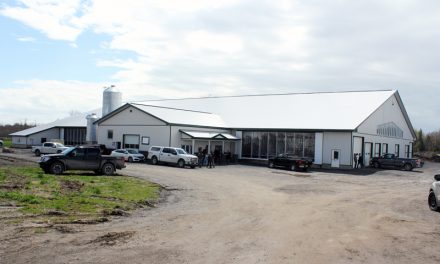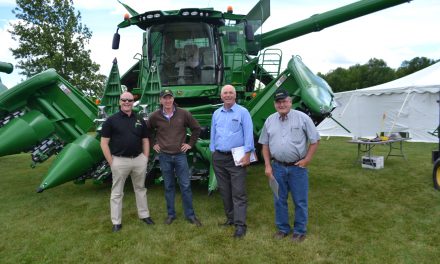Bon appétit
Human hyenas won’t flinch at eating fuzzy food in the future suggests a new art installation at the Canada Agriculture and Food Museum. Van Dusen photo
OTTAWA – He calls them “Human Hyenas’’. In Paul Gong’s world, these technically-assisted people would consume and digest rotten food just like their four-legged role models.
Gong’s vision is among a handful of art installations on display through September at the Canada Agriculture and Food Museum. Edible Futures: Food for Tomorrow certainly leaves a distinct impression that, down the road, our chow won’t be as tasty as our past and present food experience.
Gong proposes Human Hyenas as a way of tackling the problem of food waste through synthetic biology to create new bacteria and make use of tools to modify digestive systems mimicking the hyena with its different sense of smell and taste.
How about lichens – beware, some of them are toxic – and invasive species. These are some of the other items that could be on future menus according to 13 international artists assembled by the Dutch Institute of Food & Design and presented by the Embassy of the Netherlands. Hosted by the museum, the exhibit marks a world launch.
Set up in the museum’s Learning Centre, the exhibit represents a glaring contrast with some of the selections we’re more familiar with on display around the corner as part of the museum’s Food Preservation exhibition: Plump meats of every description, a vast array of colourful fruits and vegetables, and assorted bottled specialties.
Alexandra Frumstorfer’s solution to the invasive species crisis: Eat them. It’s a way of making control of such species commercially viable while protecting native ecosystems.
For Amanda Huynh, the nutrition solution can be summed up in one word: Dumplings. As we cope with climate change and other challenges, we’ll have to reconsider food that can nourish us physically and emotionally, ingredients that are hyper-local and plant based: “Our bodies know the foods familiar to those that nourished our ancestors… dumplings are what we’ll eat with the fillings changing to reflect the immediate surroundings.” In the Ottawa area, Huynh sees dumplings jam-packed with dandelion, shepherd’s purse, and Canadian thistle.
Museum director general Kerry-Leigh Burchill says Edible Futures is a unique perspective on the timely issue of food security: “We hope to spark curiosity and invite visitors to reflect on the multitude of ways we can imagine the future of food.”
As the second largest exporter of agri-food in the world, Dutch Ambassador Henk van der Zwan says his country is actively seeking solutions related to food security and “responsible consumption.” The exhibition, he maintains, highlights the role of Dutch design and art in innovation and in addressing societal challenges.
The Dutch Institute of Food & Design explores how food is created and what, why and how people eat. The institute intends to show “the relevance of food connected to design and design connected to food.”
Turning back to more conventional food items, the Agriculture Museum has some related events on its summer schedule including the annual Ice Cream Festival July 21 where visitors discover the journey from cow to cone, and Honeybee Day Aug. 17 which is all about how the sweet insects supply honey and play an instrumental role in agriculture.













